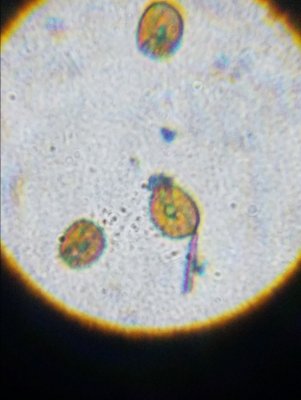- Joined
- May 22, 2016
- Messages
- 6,970
- Reaction score
- 10,747
This thread is a spin-off from the @mcarroll very successful Dino thread
The purpose is to discuss methods for removal and fighting against a particular strain of dinoflagellate - Large Cell Amphidinium. It seems to make up about a third of the cases of dinos.
The reason this strain gets its own thread is that it hugs the sand while all the other known kinds of dinos go into the water column at night, and therefore individual cells are easily targeted by UV or small micron filtration.
Reasons for splitting it off from the Dino thread:
1. Other dinos have a reliable method for direct cell removal / killing - so this information is not necessary for the 2/3 of hobbyists in the dino thread who have other kinds.
2. This kind seems to be the least toxic, in some cases not noticeably toxic at all - meaning some things that may work for this kind won't work on the others.
3. Some of this info is speculative and there may be missteps and dead ends, so best to keep the other thread with proven advice.
4. The Dino thread is huge, and digressions that don't affect most users there only make it less readable.
So if from the other Dino thread you have microscope confirmed amphidinium, first - adopt the nutrient recommendations from that thread. They absolutely apply to this kind as well. Then when you are tired of siphoning brown patches out of your sand all the time, consider giving these a try and documenting how it goes.
Treatment Methods
Best candidate: Silica dosing. The concept is that by dosing Si - which is virtually always depleted under normal tank conditions - we can grow diatoms to compete with the dinoflagellate.
Maybe the diatom bloom depletes another needed trace element, or perhaps the diatoms generate chemicals that directly suppress the dinos.
For details see this post with fairly to-the-point instructions [Several people have recently reported issues with Salifert Si test kit - beware]
For more background see this run-down of the paper it's based on.
And for general Silica reef tank discussion see Randy's article.
other ideas: Macroalgae Crowding. I have been able to chase out amphidinium outbreaks on more than one occasion by placing blobs of Chaetomorpha right on top of the brown dino patches.
for details, see my account here and also here
other ideas: Macroalgae Chemical Warfare. The seaweed Dictyota dichotoma has been found to emit chemicals that suppress dinos and force ostreopsis live cells to retreat entirely into cyst stage over the course of 20 days. The seaweed is itself considered a pest, and it may not be sensible to introduce it to chase out amphidinium which may not be very toxic at all.
Status quo: Nutrients and siphon. Handle nutrients as outlined in dino thread, vacuum out the brown patches every few days and wait it out.
The purpose is to discuss methods for removal and fighting against a particular strain of dinoflagellate - Large Cell Amphidinium. It seems to make up about a third of the cases of dinos.
The reason this strain gets its own thread is that it hugs the sand while all the other known kinds of dinos go into the water column at night, and therefore individual cells are easily targeted by UV or small micron filtration.
Reasons for splitting it off from the Dino thread:
1. Other dinos have a reliable method for direct cell removal / killing - so this information is not necessary for the 2/3 of hobbyists in the dino thread who have other kinds.
2. This kind seems to be the least toxic, in some cases not noticeably toxic at all - meaning some things that may work for this kind won't work on the others.
3. Some of this info is speculative and there may be missteps and dead ends, so best to keep the other thread with proven advice.
4. The Dino thread is huge, and digressions that don't affect most users there only make it less readable.
So if from the other Dino thread you have microscope confirmed amphidinium, first - adopt the nutrient recommendations from that thread. They absolutely apply to this kind as well. Then when you are tired of siphoning brown patches out of your sand all the time, consider giving these a try and documenting how it goes.
Treatment Methods
Best candidate: Silica dosing. The concept is that by dosing Si - which is virtually always depleted under normal tank conditions - we can grow diatoms to compete with the dinoflagellate.
Maybe the diatom bloom depletes another needed trace element, or perhaps the diatoms generate chemicals that directly suppress the dinos.
For details see this post with fairly to-the-point instructions [Several people have recently reported issues with Salifert Si test kit - beware]
For more background see this run-down of the paper it's based on.
And for general Silica reef tank discussion see Randy's article.
other ideas: Macroalgae Crowding. I have been able to chase out amphidinium outbreaks on more than one occasion by placing blobs of Chaetomorpha right on top of the brown dino patches.
for details, see my account here and also here
other ideas: Macroalgae Chemical Warfare. The seaweed Dictyota dichotoma has been found to emit chemicals that suppress dinos and force ostreopsis live cells to retreat entirely into cyst stage over the course of 20 days. The seaweed is itself considered a pest, and it may not be sensible to introduce it to chase out amphidinium which may not be very toxic at all.
Status quo: Nutrients and siphon. Handle nutrients as outlined in dino thread, vacuum out the brown patches every few days and wait it out.
Last edited:























